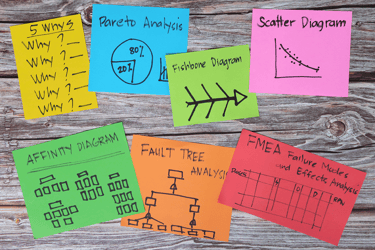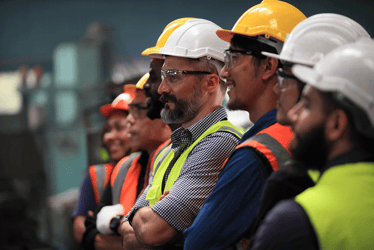The Packaging Industry's Sustainability Challenge: Why ERP Systems Are Essential for Success A straightforward guide to navigating sustainability regulations across folding carton, flexible...
Q&A: Corrugated Best Practice & the Role of Process Control
Maintaining consistency, efficiency, and product quality is a continuous challenge in corrugated manufacturing.
Best practice process control is crucial in optimizing production, reducing waste, and enhancing performance. But what exactly does it mean, and how can manufacturers ensure they follow the right approach?
To explore these questions, we sat with Neil Sillick, Process and Product Manager at ePS and an industry expert with two decades of hands-on experience in corrugated production and process control.
From his early days on the plant floor to his current role in delivering cutting-edge automation solutions, Neil shares valuable insights on the evolution of best practices, the role of AI in the industry, and how manufacturers can future-proof their operations.
Read on to discover key takeaways from our conversation, including why best practice is the foundation of process control, how technology is reshaping corrugator performance, and what the future holds for AI-driven manufacturing.
Contents
- Background & Journey into Packaging
- Understanding Best Practice & Process Control
- The Evolution of Process Control in Corrugation
- Challenges in Adoption & Operator Engagement
- Customer Implementation Process
- Measuring Success & ROI
- Addressing Machine Age & Moisture Solutions
- Future of AI & Automation in Corrugation
- Final Thoughts
Background & Journey into Packaging
Tell me about your background and how you got into packaging.
I accidentally fell into the industry. About 20 years ago, I started working on a corrugator, learning process control, and best practices – though, at the time, best practices weren’t widely recognized. Back then, we did not understand factors like paper temperature and glue application, leading to inefficient practices such as overheating paper and over using glue.
I later joined a process control team at Smurfit Kappa (now Smurfit Westrock) led by Fred Wiegman. There, we implemented best practices manually through training and Power Point presentations - no systems yet. It took years for this knowledge to fully integrate.
Around 8-10 years ago, I was introduced to an Escada corrugator control system and immediately saw its potential. Unfortunately, my factory couldn’t afford the investment then, so we tried to mimic basic functions like fixed set points for temperature control.
Fast forward, and I now work for Escada, helping implement the very technology I once wanted. With AI and machine learning advancements, we're developing systems that adapt to paper variation, machine conditions, and operator expertise, reducing ambiguity in process control.
Understanding Best Practice & Process Control
How would you explain best practice and process control to someone unfamiliar with the industry?
My mentor, Fred Wiegman, used to say, “There are a thousand ways to make cardboard, but only one correct way.” Best practice is about defining that correct way. It’s like baking a cake - there are many ways to do it, but only one ensures consistency and quality.
Best practice also optimizes energy and raw material consumption. Many assume adding more glue or heat strengthens the board, but our research has proven it unnecessary. Process control ensures every actuator - wrap arms, glue units, steam levels - is optimized to maintain consistency and efficiency. If one area is out of alignment, it can impact the entire operation.
The Evolution of Process Control in Corrugation
What comes first - best practice or process control?
Best practice is the knowledge; process control is the execution. You need to understand what you’re trying to achieve before automating it.
Where should manufacturers start if they don’t follow best practices?
Knowledge is key. There’s limited industry-wide documentation on best practices, so training is essential. Many books exist on corrugator mechanics, but they don’t define optimal performance methods. At Escada, we provide process training, as do corrugator OEMs, though our focus is solely on process control.
Challenges in Adoption & Operator Engagement
How easy is getting a customer’s team on board with a new system?
It can be challenging. Operators value their expertise and may resist automation, fearing job security. We reassure them that automation enhances their role by reducing repetitive tasks, allowing them to focus on quality control.
Long-tenured operators can be especially resistant. They’ve been running machines for 20 years and might not trust an unfamiliar system. That’s why relationship-building and ongoing support are crucial.
Customer Implementation Process
How do you approach working with a new customer?
We start with a one- to two-day survey, analyzing the machine’s condition, process inefficiencies, and areas for improvement. Based on this, we recommend solutions tailored to their needs.
Implementation includes training, and we return three months later to review progress, fine-tune settings, and address any issues. We’ve found that customers who skip this follow-up struggle more with system optimization. We’re now considering a third visit at six months to reinforce learning.
Measuring Success & ROI
How do customers measure the success of their investment?
We provide an ROI tool based on industry data, estimating expected improvements in run speed (3-6%), waste reduction, and downtime minimization. If they use Next GenClarity, they can track performance in real time; otherwise, they receive daily shift reports.
Addressing Machine Age & Moisture Solutions
Does the age of a corrugator impact the effectiveness of process control?
Not necessarily. New machines already have good control, so ROI may be lower. Older machines often see more dramatic improvements, as they typically lack efficient control mechanisms. We’ve installed systems on machines over 50 years old and significantly improved their performance.
Some technologies promote moisture addition systems. What’s your take on that?
Moisture should only be added as a last resort. The goal is to maintain balance - if paper enters at 8% moisture, it should exit at 8%. Unnecessary moisture addition can lead to post-warp issues. Some OEMs promote moisture as a first solution rather than fixing root causes. While we offer a moisture control solution, we emphasize correcting process inefficiencies first.
Future of AI & Automation in Corrugation
What’s next for process control and AI in the industry?
AI is evolving rapidly. In 20 years, AI-driven corrugators will likely be standard, but the key is ensuring the data feeding these systems is accurate. Poor AI can be worse than no AI.
At Escada, we’re already implementing AI-driven best practice monitoring - analyzing performance, recommending optimizations, and even auto-adjusting recipes. The challenge will be balancing automation with maintaining human expertise for redundancy and optimization.
Final Thoughts
Any final thoughts?
The biggest industry challenge is knowledge loss. As experienced workers retire, there’s a growing gap in expertise. Companies must prioritize training to ensure knowledge transfer. While AI will automate much of the process, human oversight remains critical.
If you want to improve your corrugator’s efficiency, reduce waste, or discuss best process control practices, we’d love to hear from you. Whether you’re just getting started or looking to optimize existing processes, our team is here to help.




